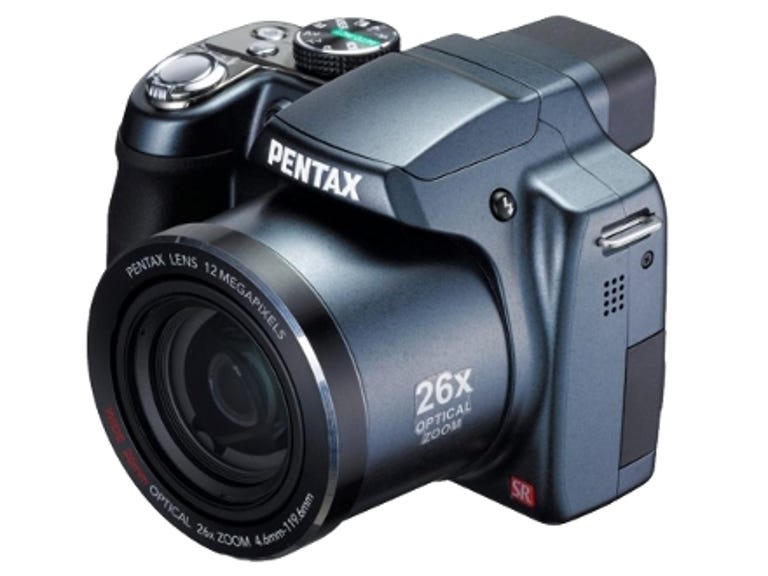 Why You Can Trust CNET
Why You Can Trust CNET Pentax X90 review: Pentax X90
The Pentax X90 is an easy-to-use superzoom that offers decent picture quality and plenty of features. It's good value for money too, although it does feel rather plasticky.
Interchangeable-lens hybrid cameras, like the Sony NEX-5, and increasingly affordable digital SLRs don't seem to have killed off the superzoom. That's because manufacturers have grown cannier with their long-zooming offerings. The Pentax X90 is a case in point, providing pretty much everything we'd expect from a superzoom in 2010. It's available now for around £230.
The Good
The Bad
The Bottom Line
Versatile snapper
The X90 boasts a 26x optical zoom with shake reduction, offering a focal range equivalent to 26-676mm in 35mm film terms. It would cost a small fortune to match that kind of scope with a dSLR.
The camera also offers high-definition movie recording at a 720p resolution in a 16:9 wide-screen ratio, at a smooth rate of 30 frames per second. An HDMI output will let you hook the camera up to a flat-screen telly.
Want to use the long lens to capture fast-moving action or sports? The X90 offers up to 11fps continuous shooting. Throw in face-detection capability with a dedicated activation button, and a perfectly acceptable resolution of 12.1 megapixels, and you have an enticing proposition for anyone who wants greater creative flexibility than a compact camera can typically provide.

Although the X90 offers three JPEG-quality levels, however, there's no unadulterated raw option. Some will view that as a significant oversight.
Plasticky carcass
The camera itself is made of plastic and metal, with more of the former than the latter on show. Our review sample's gunmetal grey finish doesn't do much to disguise the predominance of plastic, but you can also pick the X90 up in black and blue versions. Nevertheless, the X90 feels solid when gripped.
Our biggest gripe with the design is that the electronic viewfinder on the back juts out further than most, making it awkward to use if you're wearing glasses. On the other hand, at least this solves the age-old problem of the photographer's nose squashing up against the LCD when squinting into the viewfinder.
At first glance, the lens barrel seems to feature a manual focus or zoom ring. But, actually, it's just a non-rotating design detail. This ridged component at least provides something to grip when you're holding the camera steady in both hands and shooting without the aid of a tripod.
The X90 is smaller than several of its close competitors, such as the Fujifilm FinePix HS10, Kodak EasyShare Z981 and Panasonic Lumix DMC-FZ100. Its dimensions are a manageable 111 by 85 by 110mm and it weighs just 428g with a rechargeable lithium-ion battery and SD or SDHC memory card installed.
The X90 also sports larger and better-labelled controls than its rivals, including a chunky shooting-mode dial, direction pad and shutter-release button, which is surrounded by the zoom lever. Keep your finger on this lever once you've reached the end of the optical zoom range and an 'intelligent zoom' feature kicks in, with incremental resolution drops. Telephoto performance is boosted to either 33.9x at 7 megapixels, or a frankly ridiculous 162.5x, if you don't mind shooting at a fuzzy 640x480-pixel resolution and getting results that resemble a bad trip.
Shoot yourself silly
With a press of the recessed power button on the top plate, the user can be up and shooting in just under 2 seconds. That includes the lens extending to the maximum wide-angle setting and the rear 69mm (2.7-inch), 230,000-dot LCD display bursting into life.
The X90's ten-option mode dial offers a full complement of shooting modes, including program, aperture priority, shutter priority, manual, and 'auto picture', which compares scenes with eight on-board presets and selects the most appropriate. The auto picture mode is mostly reliable, although it can be momentarily hoodwinked by busy scenes.
Located on the same dial is the video-capture mode -- there's no dedicated, one-touch record button. Filming commences and ends with a press of the shutter-release button, which is fine. Although the mechanism used to power the zoom isn't particularly loud in our opinion, Pentax has chosen to play it safe and disable the optical zoom when recording movies. This is a mistake that loses the camera a star.
On a brighter note, committing a maximum-resolution JPEG to the memory card takes just 2 seconds. The X90's ISO range is respectably broad too, stretching from ISO 80 to ISO 6,400, even if performance is actually pretty average. Noise rears its head at ISO 1,600 and, at ISO 6,400, detail starts to seriously deteriorate as in-camera processing tries to disguise the increasing grain.
With plenty of light, though, images are rich and colourful. We were impressed by the amount of detail the X90 resolves, even when shooting at the extreme end of its zoom range.
Conclusion
The Pentax X90 packs in plenty of features for the money, handles well and produces images that transcend its modest asking price, although you may find you have to tweak the brightness and contrast slightly with some editing software. It's a shame the build quality is plasticky in places, and the camera lacks the external sophistication of its Fujifilm, Nikon and Panasonic rivals. But, if you want to upgrade from a humble compact without consigning your family to a life of abject poverty, you could do far worse than the X90.
Edited by Charles Kloet
